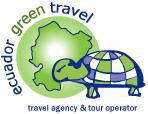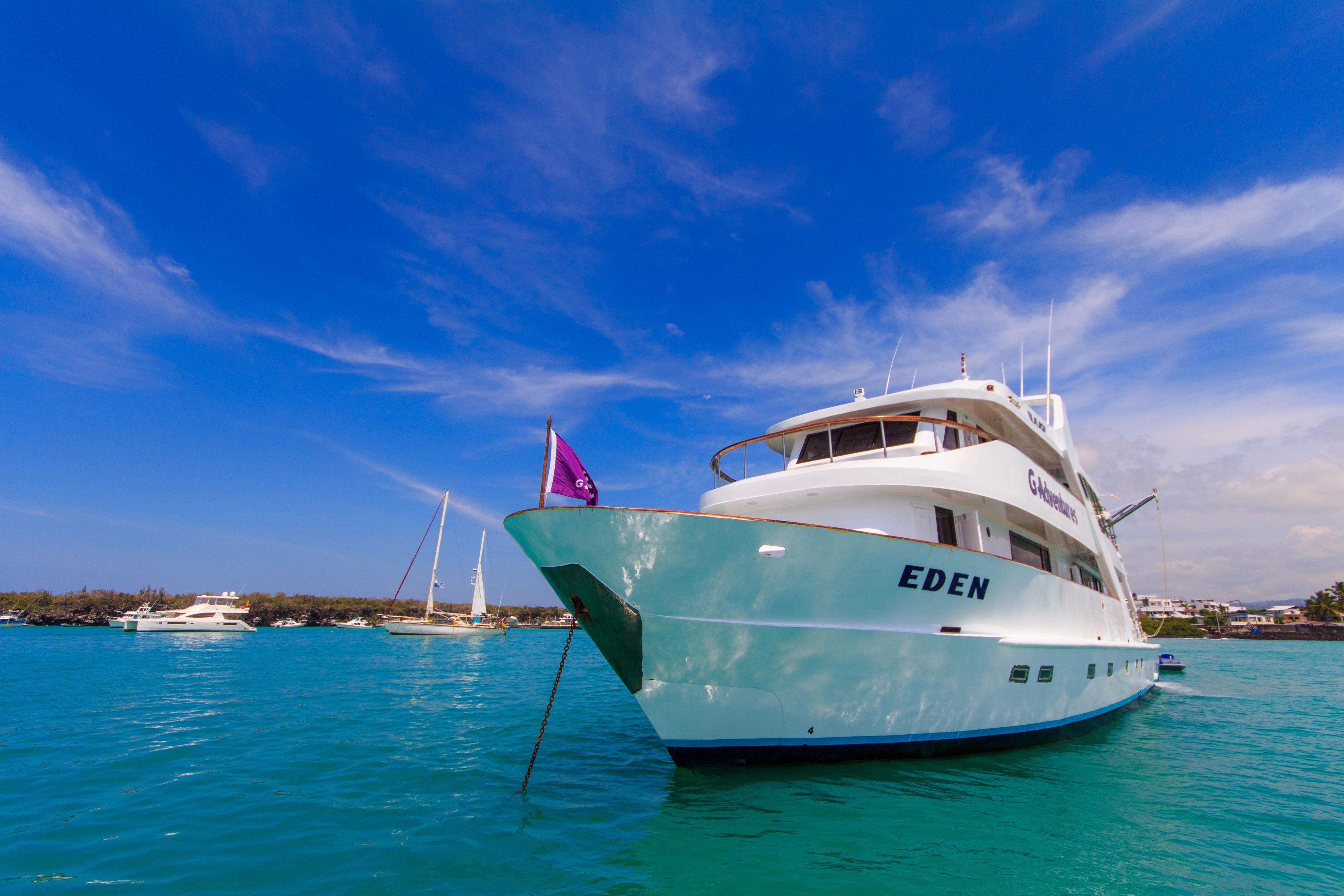DAY 1: SUNDAY
BALTRA ISLAND: AIRPORT / SANTA CRUZ ISLAND: PUNTA CARRIÓN
You will be met in the arrival hall of the airport by a National Park Guide, and transferred to the catamaran ‘M.Y Grand Queen Beatriz’. Lunch will be served on the boat. Your first stop in the afternoon will be Punta Carrion, located in north-eastern Santa Cruz. This is a shallow and protected cove, ideal for your first snorkel and swim in the Galapagos! Wildlife is plentiful; keep your eyes peeled for blue-footed boobies, Galapagos herons, great blue herons and underwater swim among rays and white-tipped reef sharks.

DAY 2: MONDAY
ISABELA ISLAND: TINTORERAS ISLET, GIANT TORTOISES BREEDING CENTER & WALL OF TEARS
Today you will wake up on the South Coast of Isla Isabela, the largest of the Galapagos Archipelago. Isabela was formed by five giant volcanic craters, all of which are still considered active. The island is located in one of the youngest geological areas in the world, having been formed less than 1 million years ago.
This southern coast of turquoise blue waters has the largest area of beaches in the Galapagos. You will visit Las Tintoreras, where from the viewing walkway you can look down into this narrow channel to see a colony of white-tipped reef sharks swimming and sleeping, and the occasional playful sea lion among them!
Blue-footed boobies and penguins, marine iguanas and crabs also make their home here, and the waters provide further opportunities to swim with turtles. Here you will also visit the Giant Tortoise breeding center and the Wall of Tears, constructed from lava by prisoners of the penal colony here between 1946 and 1959 as punishment. Please note there's a US$5 fee to be paid upon entering Isla Isabela.

DAY 3: TUESDAY
FLOREANA ISLAND: CORMORANT POINT, DEVIL´S CROWN & POST OFFICE BAY
The island of Floreana is a highlight of any Galapagos cruise, rich in natural wonders and wildlife. You will go ashore at Punta Cormorant where the sand is made up of fine olivine crystals, a glassy volcanic mineral, giving the beach an olive-green color. It is the best place to see Galapagos sea lions.
Today is also one of your finest opportunities to see pink flamingos and other water birds wading in the lagoons, including pintails and stilts. Just offshore, the Devil’s Crown is an old eroded volcanic cone and a popular roosting site for seabirds such as boobies, pelicans and frigates. Red-billed tropicbirds can also be seen nesting in the rocky crevices.
The center of the cone is an outstanding snorkeling spot, perhaps the most remarkable in the entire archipelago, full of sea lions and colorful fish. Floreana is also home to Post Office Bay, where 18th century whalers used a barrel as an unofficial mail drop. This custom continues to this day with visitors to the Galapagos – post one of your own, or see if there are any you could deliver back home!

DAY 4: WEDNESDAY
SANTA CRUZ ISLAND: CHARLES DARWIN RESEARCH STATION & HIGHLANDS
Today you will visit Santa Cruz, the second largest island in the Galapagos. Afterward you'll head up into the highlands for a total change of scenery. Beginning at the coast you will travel across Santa Cruz through the agricultural region and into the misty forests. This is a lush humid zone containing miconia bushes, scalesia and inactive volcanic cones. Santa Cruz has more endemic plants than any of the other islands and you are likely to see Galapagos giant tortoises in their natural habitat and perhaps even the bright red feathers of a vermillion flycatcher!
The small town of Puerto Ayora is the economic center of the archipelago, and home to the Charles Darwin Research Station. As well as undertaking vital conservation work, the station also makes for interesting exploration and offers the best opportunities for close encounters with giant tortoises, you will also observe baby tortoises and land iguanas.\

DAY 5: THURSDAY
SANTA FE ISLAND & SOUTH PLAZAS ISLAND
Santa Fe is home to more sea lions, and these ones are very eager for swimming partners! It’s a lovely place to take a dip, and the landscape on the inland trails is also beautiful, with cacti forests home to a unique sub-species of land iguanas. Hiking towards the cliffs on Santa Fe will lead you to a forest of prickly pear cactus.
A member of the cactus family, their name comes from the pear shaped fruit the plant produces. Santa Fe is home to endemic land iguanas. Once back at the beach you will have free time to snorkel back in the lagoon. Playful sea lions pups and florescent fish make for fascinating company. A small island, Plaza Sur is nonetheless a place of great beauty, where you will get close to sea lions and onto trails past one of the Galapagos’ largest land iguana populations, resting amid cacti and volcanic landscapes colored bright red and green by sesuvium. The island’s rugged southern cliffs are an excellent place to spot tropicbirds and swallow-tailed gulls, as well as ‘the gentlemen’s club’, a gathering of male sea lions either too young or too old to be beach masters!

DAY 6: FRIDAY
ESPAÑOLA ISLAND: GARDNER BAY & SUÁREZ POINT
Today you will cruise to the island of Española - the southernmost island of the Galapagos and one of the most spectacular. Because of its remote location, this island has a large population of endemic fauna. It is the breeding site for nearly all of the world's 12,000 pairs of waved albatrosses and also home to colonies of blue-footed and masked boobies.
Trails from the golden beaches, where sea lions bathe and marine iguanas make their way towards the water, will lead you right through the middle of booby colonies, and Galapagos doves and mockingbirds are also often seen. You will also visit the beautiful white sandy beaches at Bahia Gardner, which are great places for swimming and relaxing. The rocks off the coast provide excellent snorkeling opportunities, with reef sharks, turtles and many species of tropical fish, including surgeon and angelfish, often seen. The small white-tipped reef sharks are also often spotted resting under the rocks.
You will also pay a visit to Punta Suarez, one of the most attractive locations in the Galapagos and home to large and varied wildlife population - a walk along its trails will take you to a cliff top viewpoint, where you'll gain a magical panorama. Boobies line the rocky shoreline beneath you, while frigate birds may be seen overhead; nearby enormous male sea lions can be seen lounging and albatross use the cliffs as their ‘runway’, helping become airborne by the southeast winds that blow across this part of the island.
If you’re lucky you’ll see the elaborate courtship rituals performed by albatrosses before the female chooses her lifelong mate!

DAY 7: SATURDAY
SAN CRISTOBAL: PITT POINT, KICKER ROCK & LOBOS ISLAND
This morning you will visit Punta Pitt on the eastern end of Isla San Cristobal. Walk to the top of the volcanic hill for expansive views of the sparsely vegetated area. A variety of seabirds nest here, including blue-footed boobies and frigates.
Close by you will pass through Leon Dormido (Kicker Rock), which is a magnificent rock in the middle of the sea, the shape resembles a sleeping lion. The rock rises 150 meters above the surface and is divided into two parts by a narrow channel.
You will also visit Isla Lobos, a tiny island almost touching Isla San Cristobal. This is the perfect time to witness the always friendly sea lions as they play in the calm shallow waters here Blue-footed boobies, frigate birds and marine iguanas are also easily seen.

DAY 8: SUNDAY
SAN CRISTOBAL: INTERPRETATION CENTER & AIRPORT
As flights to the mainland from Galapagos depart mid-morning, it is an early start for our last morning on the islands. Depending on the time of our flight, our time spent on this final excursion could be limited.
Visit the Interpretation Centre in the morning. The center brings the history and geography of the archipelago to life, from its volcanic origins to the present day. The human history exhibit offers an insight into the discovery and colonization of the Galapagos, and the reality of the problems the islands face today is also explored.
This is a great way to complete your time in the Galapagos. This will be your final excursion before you head to the airport in San Cristobal for your flight back to Quito. As you will be leaving the boat this morning, please remember that if you have enjoyed the services provided by your guide and crew, a tip would be very much appreciated by them.
As a guideline we recommend each passenger consider US$15 per day for the crew and US$10 per day for your guide. You can leave tips in envelopes that are placed in your cabin on this last day of your journey.


























